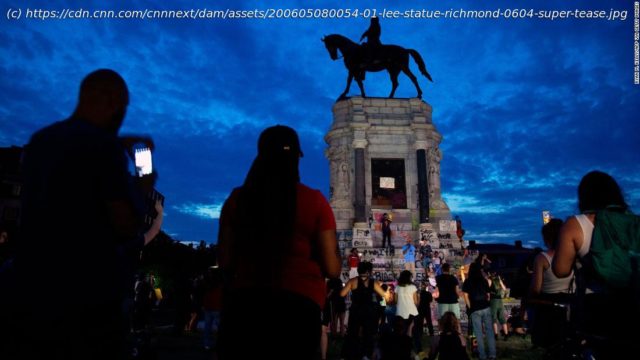Statues are products of one era built to endure into others. They loom over streets and squares while the views of those who pass by change, from generation to generation. Most people, most of the time, are indifferent to these persons of stone and bronze. Not now.
Statues are products of one era built to endure into others. They loom over streets and squares while the views of those who pass by change, from generation to generation. Most people, most of the time, are indifferent to these persons of stone and bronze. Not now.
From Richmond, Virginia, to Bristol in England, statues of men who championed or traded in slavery centuries ago are being torn down. The soul-searching about race prompted by the death of George Floyd in Minneapolis has extended into how the history of racial persecution and prejudice is remembered. It is a heated debate that reaches far beyond the legacy of slavery.
Statues of the Confederate Gen. Robert E. Lee in the US and the 17th century British slave-trader Edward Colston were obvious targets for anti-racism protesters. So were those of King Leopold of Belgium, who presided over the most atrocious cruelty in Belgian-run Congo in the late 19th century. His statue in Antwerp was set on fire and doused in paint last week.
Few today would defend commemorating or honoring figures like Colston or Leopold. They profited from cruelty and persecution, and hundreds of thousands of Africans died in the process.
People gather around the Robert E. Lee statue in Richmond, Virginia, on June 4, calling for its removal. CNN has blurred expletives written on the base of the statue.
Similarly, there are moments in history where destroying icons has been part of a popular urge for liberation. During the 1956 uprising in Hungary, crowds tore down the huge bronze statue of Joseph Stalin, a gift to the Soviet leader on his 70th birthday. In 2003, Iraqis toppled a statue of President Saddam Hussein in Baghdad, helped by US Marines.
Read More
But most historical figures are not so easily categorized and condemned. Now British wartime leader Winston Churchill and Italian explorer Christopher Columbus are among those in the cross-hairs of some protesters.
Churchill’s statue in Westminster, defaced with the words « was a racist » last week, was covered up ahead of this weekend’s protests. British Prime Minister Boris Johnson, who wrote a biography of Churchill, was furious — saying on Twitter that his predecessor was a hero and had saved « this country — and the whole of Europe — from a fascist and racist tyranny. »
Johnson acknowledged that Churchill had « sometimes expressed opinions that were and are unacceptable to us today, » but said he was averse to tampering with history.
The statue of Edward Colston is recovered from the harbour in Bristol, England, on Thursday, June 11, after it was toppled by anti-racism protesters last weekend.
« The statues in our cities and towns were put up by previous generations, » he tweeted. « They had different perspectives, different understandings of right and wrong. But those statues teach us about our past, with all its faults. To tear them down would be to lie about our history, and impoverish the education of generations to come. »
American comedian Trevor Noah has a different take: « The bubonic plague was a major event in history, but we don’t go around putting up statues of rats, » he wrote.
Setting aside the likes of the nurse Florence Nightingale (whose statue lies not far from that of Churchill), most of the great figures of the past are not beyond reproach — especially by today’s standards.
Robert Shrimsley wrote in the Financial Times: « Many great historic figures carry serious baggage. George Washington and Thomas Jefferson owned slaves. Where does the historic cleansing stop? »
Most would probably agree that Churchill led resistance to the Nazis heroically, but some remember him also as a white supremacist. In 1937, when addressing the fate of indigenous peoples in Australia and America: « I do not admit that a wrong has been done to these people by the fact that a stronger race, a higher-grade race, a more worldly wise race to put it that way, has come in and taken their place. »
In the United States, statues of Columbus have been damaged or torn down by protesters in the past few days because of his brutal suppression of indigenous people when exploring the New World.
A parks worker inspects a statue of Christopher Columbus that had its head removed at Christopher Columbus Waterfront Park on June 10 in Boston, Massachusetts.
Home
United States
USA — mix Cathartic acts of rage, or the rewriting of history? How statues became...






